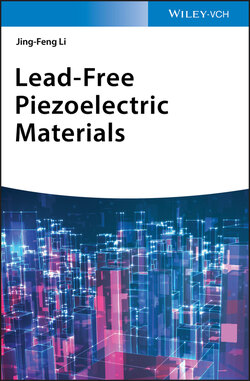Читать книгу Lead-Free Piezoelectric Materials - Jing-Feng Li - Страница 23
References
Оглавление1 1 Coursey, P.R. and Brand, K.G. (1946). Dielectric constants of some titanates. Nature 157: 297–298.
2 2 Roberts, S. (1947). Dielectric and piezoelectric properties of barium titanate. Physical Review 71 (12): 890.
3 3 Shirane, G. and Takeda, A. (1952). Phase transitions in solid solutions of PbZrO3 and PbTiO3: I. Small concentrations of PbTiO3. Journal of the Physical Society of Japan 7: 5–11.
4 4 Shirane, G. and Suzuki, K. (1952). Crystal structure of Pb(Zr–Ti)O3. Journal of the Physical Society of Japan 7: 333–333.
5 5 Sawaguchi, E. (1953). Ferroelectricity versus antiferroelectricity in the solid solutions of PbZrO3 and PbTiO3. Journal of the Physical Society of Japan 8: 615–629.
6 6 Jaffe, B., Roth, R.S., and Marzullo, S. (1954). Piezoelectric properties of lead zirconate–lead titanate solid‐solution ceramics. Journal of Applied Physics 25: 809–810.
7 7 Jaffe, B., Cook, W.R., and Jaffe, H. (1971). Piezoelectric Ceramics. Academic Press.
8 8 Haertling, G.H. (1999). Ferroelectric ceramics: history and technology. Journal of the American Ceramic Society 82: 797–818.
9 9 Uchino, K. (1997). Piezoelectric Actuators and Ultrasonic Motors. Boston, MA: Kluwer Academic Publishers.
10 10 Trolier‐McKinstry, S. and Randall, C.A. (2018). Movers, shakers, and storers of charge: the legacy of ferroelectricians L. Eric Cross and Robert E. Newnham. Journal of the American Ceramic Society 100: 3346–3359.
11 11 EU‐Directive 2002/95/EC (2003). Restriction of the Use of Certain Hazardous Substances in Electrical and Electronic Equipment (RoHS). Official Journal of the European Union 46 (L37): 19.
12 12 Takenaka, T. and Nagata, H. (2005). Current status and prospects of lead‐free piezoelectric ceramics. Journal of the European Ceramic Society 25: 2693–2700.
13 13 Saito, Y., Takao, H., Tani, T. et al. (2004). Lead‐free piezoceramics. Nature 432: 84–87.
14 14 Shrout, T.R. and Zhang, S.J. (2007). Lead‐free piezoelectric ceramics: alternatives for PZT? Journal of Electroceramics 19: 111–124.
15 15 Roedel, J., Jo, W., Seifert, K.T.P. et al. (2009). Perspective on the development of lead‐free piezoceramics. Journal of the American Ceramic Society 92: 1153–1177.
16 16 Li, J.‐F., Wang, K., Zhu, F.‐Y. et al. (2013). (K,Na)NbO3‐based lead‐free piezoceramics: fundamental aspects, processing technologies, and remaining challenges. Journal of the American Ceramic Society 82: 797–818.
17 17 Roedel, J. and Li, J.‐F. (2018). Lead‐free piezoceramics: status and perspectives. MRS Bulletin 43: 576–580.
18 18 Trolier‐McKinstry, S., Zhang, S.J., Bell, A.J., and Tan, X.L. (2018). High‐performance piezoelectric crystals, ceramics, and films. Annual Review of Materials Research 48: 191–217.
19 19 Guo, R., Cross, L.E., Park, S.E. et al. (2000). Origin of the high piezoelectric response in PbZr1−xTixO3. Physical Review Letters 84: 5423–5426.
20 20 Noheda, B., Cox, D.E., Shirane, G. et al. (2001). Stability of the monoclinic phase in the ferroelectric perovskite PbZr1−xTixO3. Physical Review B 63: 014103.
21 21 Noheda, B. (2002). Structure and high‐piezoelectricity in lead oxide solid solutions. Current Opinion in Solid State and Materials Science 6: 27–34.
22 22 IEEE Standard on Piezoelectricity. (1987). ANSI/IEEE, Standard 176‐1987.
23 23 Lines, M.E. and Glass, A.M. (1979). Principles and Applications of Ferroelectrics and Related Materials. Oxford: Clarendon.
24 24 Cady, W.G. (1946). Piezoelectricity: An Introduction to the Theory and Applications of Electromechanical Phenomena in Crystals. McGraw‐Hill.
25 25 Sawyer, C.B. and Tower, C.H. (1930). Rochelle salt as a dielectric. Physical Review 35: 269–273.
26 26 Mitsui, T., Tatsuzaki, I., and Nakamura, E. (1976). An Introduction to the Physics of Ferroelectrics. London: Gordon and Breach.
27 27 Damjanovic, D. (1998). Ferroelectric, dielectric and piezoelectric properties of ferroelectric thin films and ceramics. Reports on Progress in Physics 61: 1267–1324.
28 28 Jin, L., Li, F., and Zhang, S.J. (2014). Decoding the fingerprint of ferroelectric loops: comprehension of the material properties and structures. Journal of the American Ceramic Society 97: 1–27.
29 29 Berlincourt, D. and Jaffe, H. (1958). Elastic and piezoelectric coefficients of single‐crystal barium titanate. Physical Review 111: 143–148.
30 30 Jaffe, H. and Berlincourt, D.A. (1965). Piezoelectric transducer materials. Proceedings of the IEEE 53: 1372–1385.
31 31 Cain, M.G. (2014). Characterisation of Ferroelectric Bulk Materials and Thin Films. Springer.
32 32 Yamaguchi, T. and Hamano, K. (1979). Inteferometric method of measuring complex piezoelectric constants of crystals in a frequency range up to about 50 kHz. Japanese Journal of Applied Physics 18: 927–932.
33 33 Zhang, Q.M., Pan, W.Y., and Cross, L.E. (1988). Laser interferometer for the study of piezoelectric and electrostrictive strains. Journal of Applied Physics 63: 2492–2496.
34 34 Li, J.‐F., Moses, P., and Viehland, D. (1995). Simple, high‐resolution interferometer for the measurement of frequency‐dependent complex piezoelectric responses in ferroelectric ceramics. Review of Scientific Instruments 66: 215–221.
35 35 Moilanen, H. and Leppävuori, S. (2001). Laser interferometric measurement of displacement‐field characteristics of piezoelectric actuators and actuator materials. Sensors and Actuators A 92: 326–334.
36 36 Warner, A.W., Onoe, M., and Coquin, G.A. (1966). Determination of elastic and piezoelectric constant in class (3M). Journal of the Acoustical Society of America 42: 1223–1231.
37 37 Fialka, J. and Benes, P. (2013). Comparison of methods for the measurement of piezoelectric coefficients. IEEE Transactions on Instrumentation and Measurement 62: 1047–1057.
